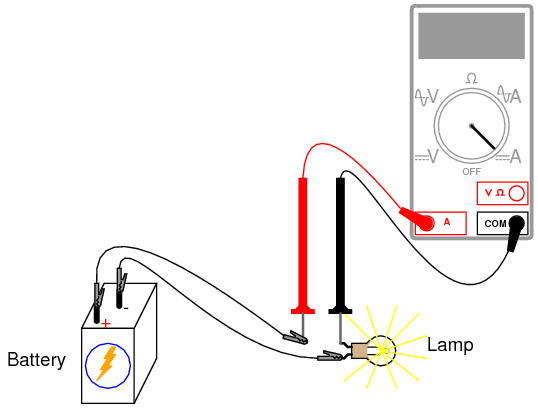How to measure current using Ammeter
Current is the measure of the rate of flow of electric
charges across the conductor. It is measured in the unit of Ampere. This
current is most commonly measured by ammeter.
Ammeter
Ammeter measure the electric current in the circuit. The
name is derived from the SI unit of electric current, ampere. To measure
electric current in a circuit, ammeter must be connected in series because in
series connection, ammeter experiences the same amount of current that flows in
the circuit. Ammeter is designed to work with small fraction of volt. So
voltage drop must be minimal.
Symbol of Ammeter
The capital A represents the ammeter in the circuit.
How to use an ammeter
Before we start measuring current, we will first set the
ammeter range. Keeping the range to highest will prevent the ammeter to blow up
its internal fuse. Then set the current type i.e. DC or AC.
Now connect the terminals of ammeter in series of the
resistance or load. By this arrangement, ammeter experiences the same amount of
current that flows in the circuit. For example let us assume the simple
circuit; a bulb is connected to the battery. Positive terminal of battery is
connected to positive terminal of lamp and negative terminal of battery is connected
to negative terminal of lamp.
Now disconnect any one terminal of the bulb and connect the
ammeter in such a way that one probe of ammeter is connected to battery and
another probe is connected to bulb.
You can now observe readings in ammeter and that is amount
of current flowing in your circuit.
Now once you have noted readings from ammeter disconnect the
ammeter and connect the wires as in simple circuit back.
CAUTION:
Do not connect your ammeter’s probes directly to battery to
check the current of that battery. This will create a short circuit in the
ammeter and sometimes this activity can blow your ammeter’s internal fuse. So
please do not perform this activity.
If you want to check current of the battery. Add a
resistance across battery and connect an ammeter in series. The readings will
be correct and accurate, no need to worry.
Ammeter shunt
When high value of current is passed through ammeter, this
damages the internal circuit of ammeter. For this a resistance is connected in
parallel to ammeter. So, large amount of current will pass through that
resistor. And of course this shunt resistance does not affect the working of
ammeter.
So, this is how you should use ammeter with all the
precautions and measures. Ammeter has made calculations of current in
electrical devices very easy and now with ammeter we can measure small currents
in µA
to large currents in kA.



Comments
Post a Comment